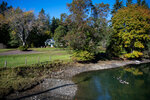

A new chapter has begun for an old farmhouse at the head of Glen Cove. Where once the McColley family rose in the dark to feed cows before school, camp staff now have a place to lay their heads away from their energetic charges.
YMCA Camp Seymour closed on the McColley property, just across Cramer Road from the camp, in July for $1.5 million. The largely forested 19-acre property includes the tidal cove and creek beyond the Glen Cove bridge as well as one of the community’s early homesteads.
For years Pearlita McColley welcomed visiting camp students to come down to the creek to see salmon. When she passed away in July at the age of 89, her children reached out to parks departments, Great Peninsula Conservancy and Camp Seymour. (See McColley’s obituary in the KP News, July 2022.)“I would’ve loved to have bought it,” said Marleigh Nodtvedt, one of her children. But she and her siblings are in their 60s and know the work it requires to keep up a homestead. Granted, Notdvedt acknowledged it kept her mother in shape: The last time she saw her, Pearlita was on a riding lawnmower.
Their hope was for conservation of the property and access for the public to enjoy it. “I kind of wanted something like 360 Park, Gateway Park,” Nodtvedt said.
But conservation funding was going to take too long to materialize. The YMCA ruefully declined. “I had no margin on my end,” said Charlie Davis, CEO of the YMCA of Pierce and Kitsap Counties. “We were really hurt from Covid.”
The McColley children put it on the market. Soon after, Davis mentioned the property to a donor who saw how perfect it would be for camp. A second donor appeared, inspired by the first. Within two weeks the purchase had begun.
“The way this happened was mind-blowing, really,” Davis said.
Two staff members lived in the house this summer. A 1926 farmhouse, it has five bedrooms but only one-and-a-half baths. The inspection revealed nothing more substantial than a list of minor repairs. According to Scotty Jackson, director of Camp Seymour, the plan is to modernize the house for use as staff housing — replacing the oil furnace with a heat pump, adding bathrooms — and keep other infrastructure to the homestead’s already developed footprint.
While Jackson is waiting until spring to gather his local advisory council, board members and past educators to walk the property and begin to formulate a plan, he and Davis agreed that the real value for Camp Seymour is in the land and habitat. The cove with its salmon run and the creek that feeds the estuary — “These are all things we teach the kids about,” Jackson said. They envision trails.
“This was a huge gift for the camp. Game changer for us,” Davis said.
Preservation is the intention. The camp will look into conservation easements. Jackson hopes to consult with the Squaxin Island Tribe. There is a shell midden on the camp property where campers will learn about village life, as well as how indigenous people fished and spent time together in Glen Cove. Jackson says he can imagine that the creek mouth on the McColley property would have been used in such a way.
He also hopes to rebuild the barn that once stood behind the house. Beyond moving equipment storage away from its current location on the shoreline, it would tie in with the camp’s educational lessons on the energy cycle, composting, vegetable growing — even perhaps a return of the pigs once kept by the camp.
One wrinkle is the county’s planned reconstruction, likely in 2024, of the Glen Cove bridge. With the bridge out for a summer season, the McColley property will be a six-mile drive from camp.
Nodtvedt said she remembers when the house was linked by a party line to other homes on the cove. “My mom and dad had a long relationship with the Y,” she said. She grew up alongside the camp directors and their children. She remembers getting all the apples and huckleberries they needed from the land as well as good well water. They had a rowboat they would take back into the creek.
“It’s just pretty,” Nodtvedt said.
Her parents, concerned about drowning, taught her to swim at a young age. She learned that when the tide comes in, the cove water is warm on top, heated by sun-warmed mudflats. When the tide goes out, an inch of cold water from the creek sits on the surface.
When an old chicken house began to sag, her parents invited the whole community over for cider and snacks and had the fire department do a controlled burn of the structure.
She hopes that spirit of community involvement will continue. “I’m just glad it’s still somewhat public access. I would like something where we can wander the property. I don’t think that will happen with the Y, but at least people can pay for camp and go through it that way.”
For Jackson, the situation reminds him of a time 117 years ago, when William Wolcott Seymour first invited a group of boys to camp on his land. Within a few years, tents had been erected. In 1920 Seymour donated the land to the YMCA, and the camp was officially dedicated in 1927. The rest is history. (See “Camp Seymour Gears up for Centennial Celebrations,” KP News, January 2005.)
UNDERWRITTEN BY THE FUND FOR NONPROFIT NEWS (NEWSMATCH) AT THE MIAMI FOUNDATION, THE ANGEL GUILD, ADVERTISERS, DONORS AND PEOPLE WHO SUPPORT INDEPENDENT, NONPROFIT LOCAL NEWS